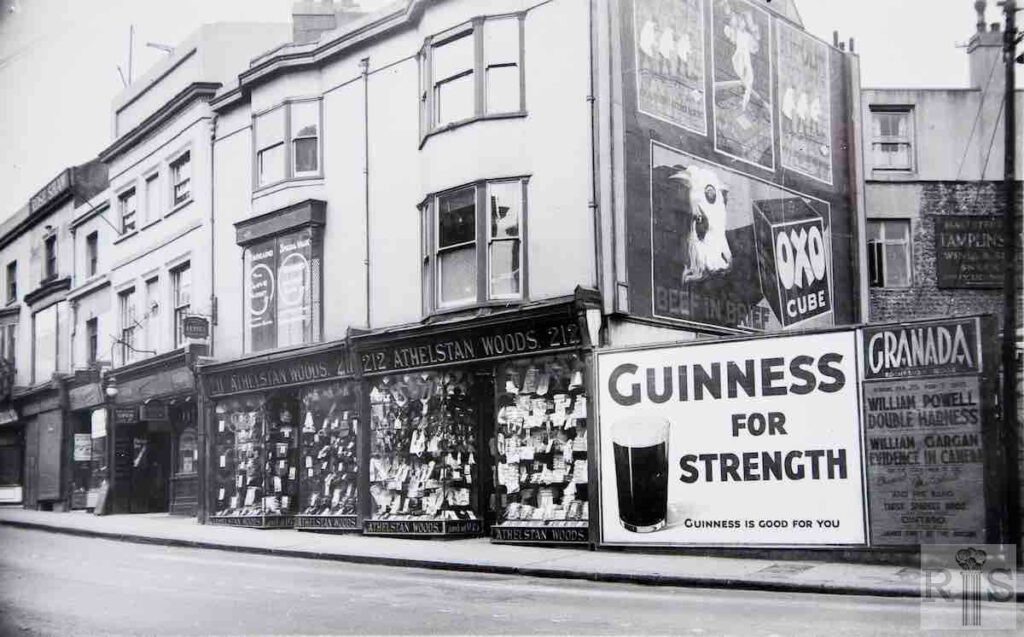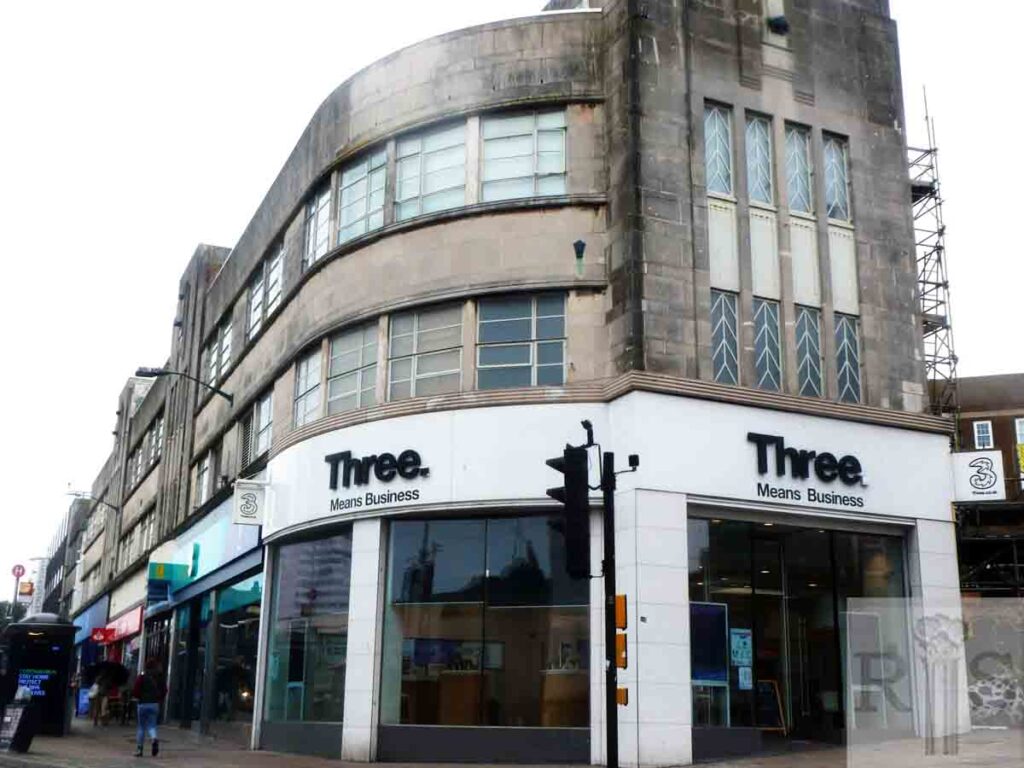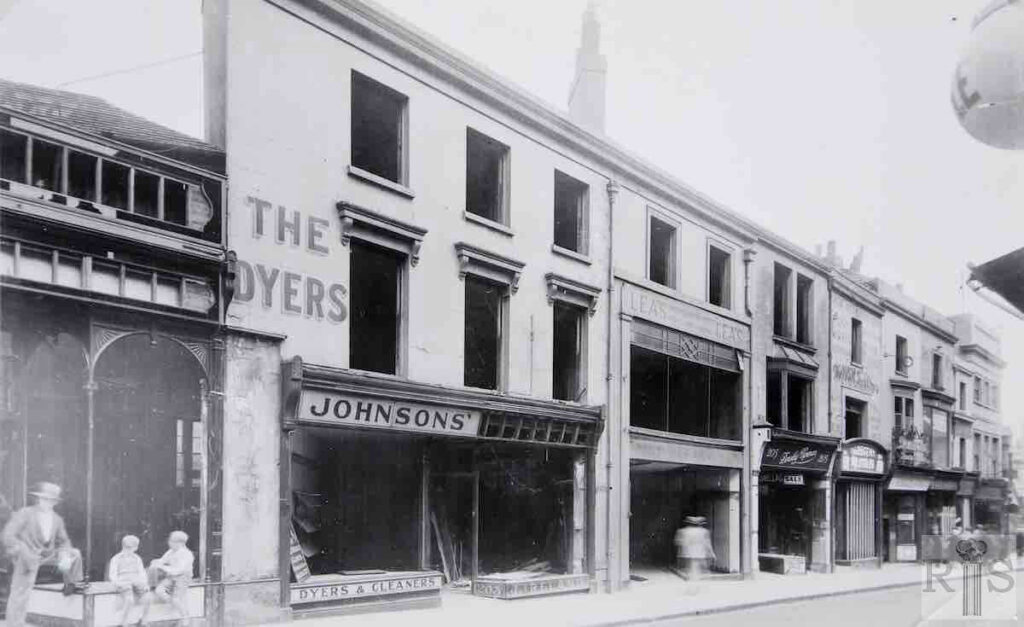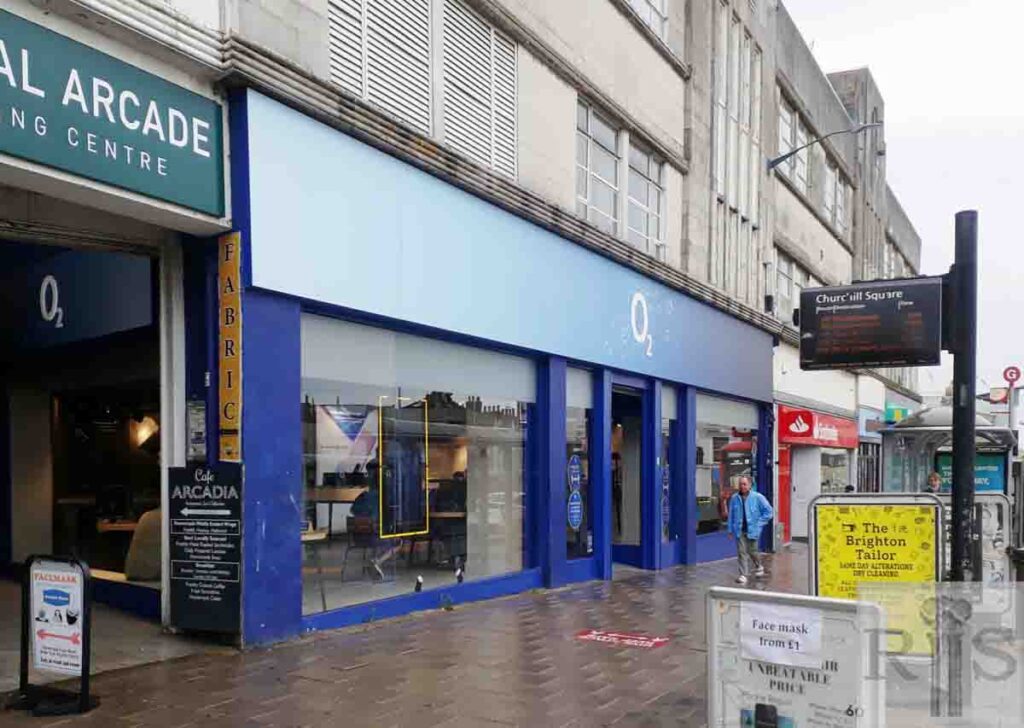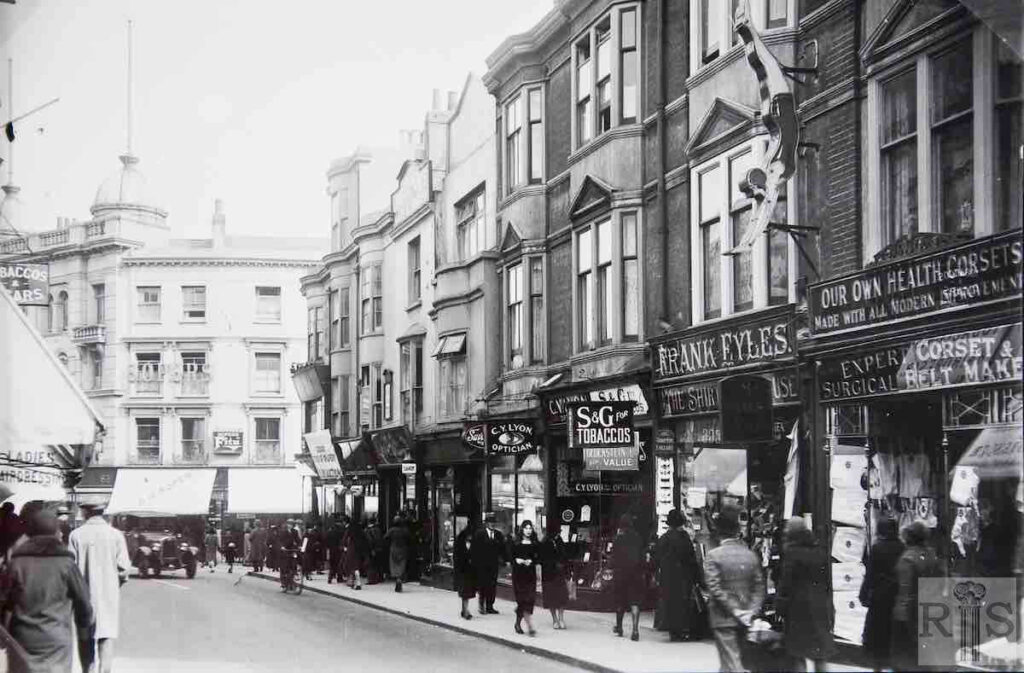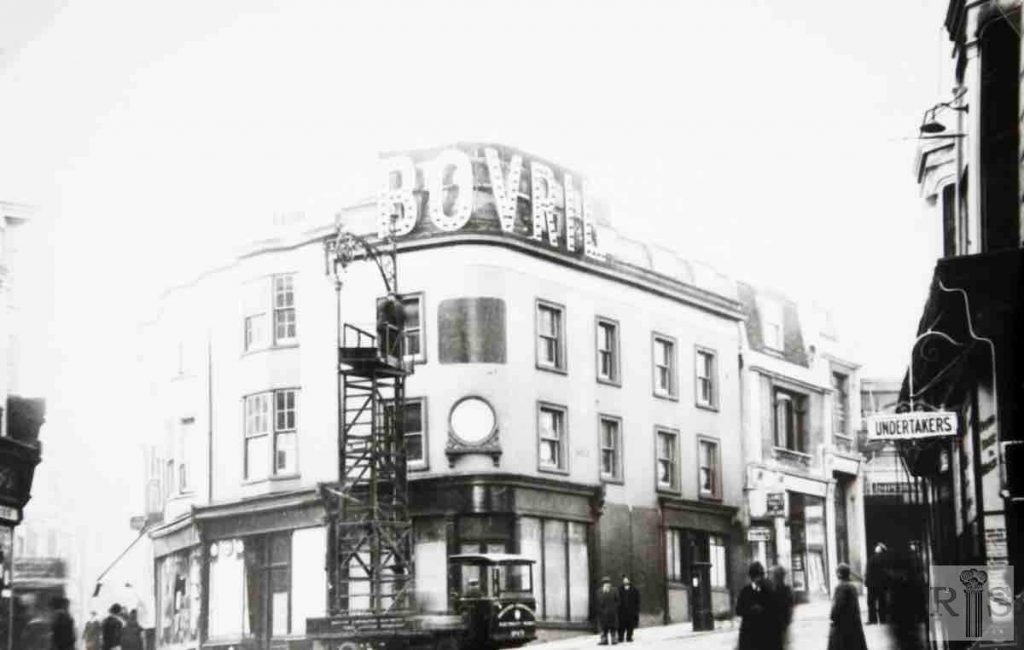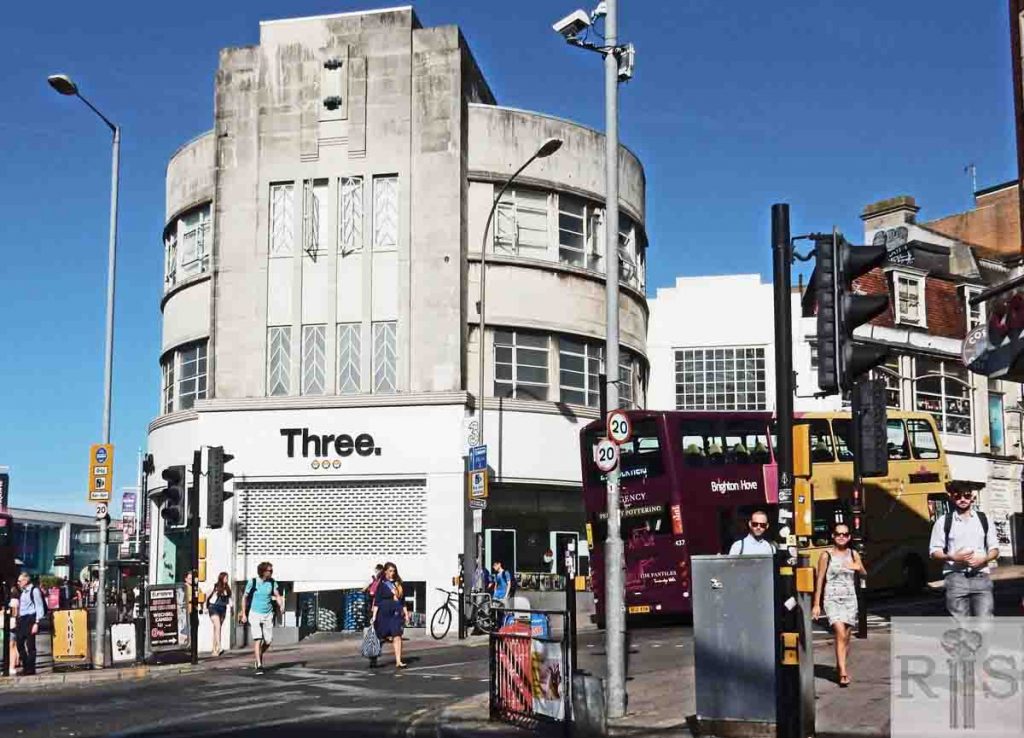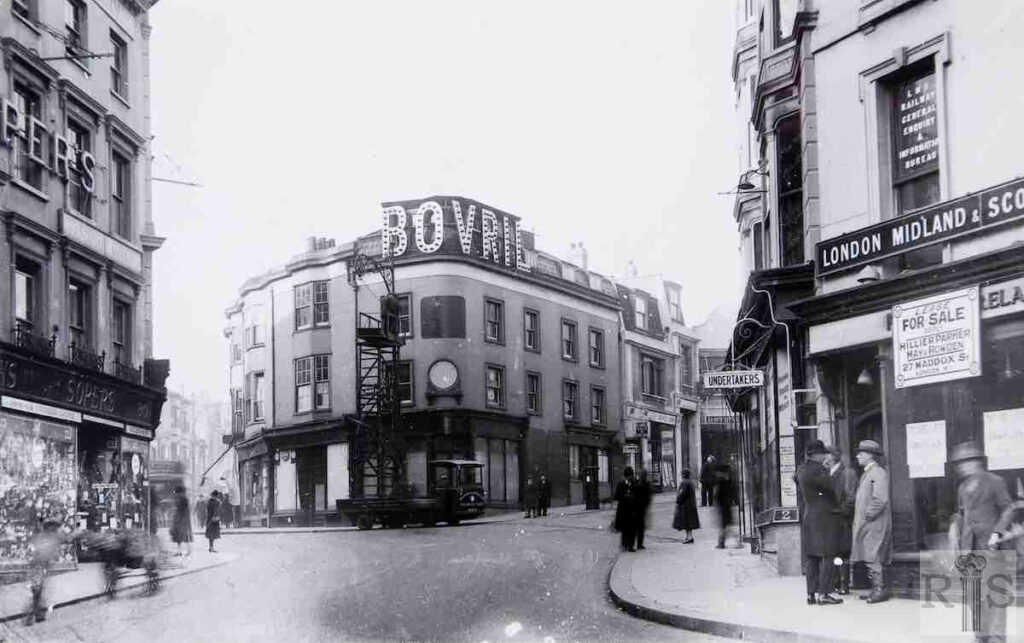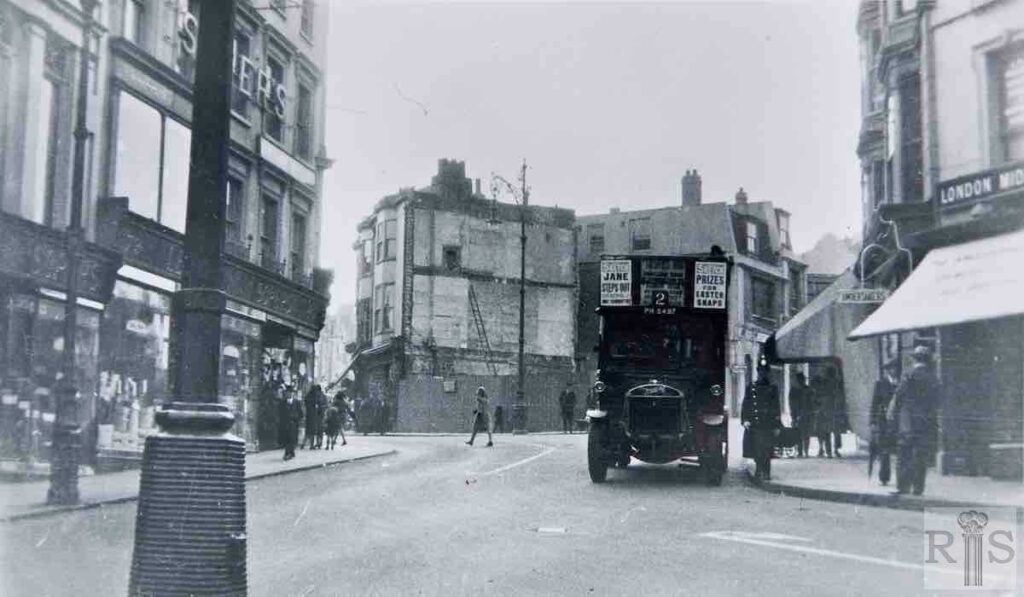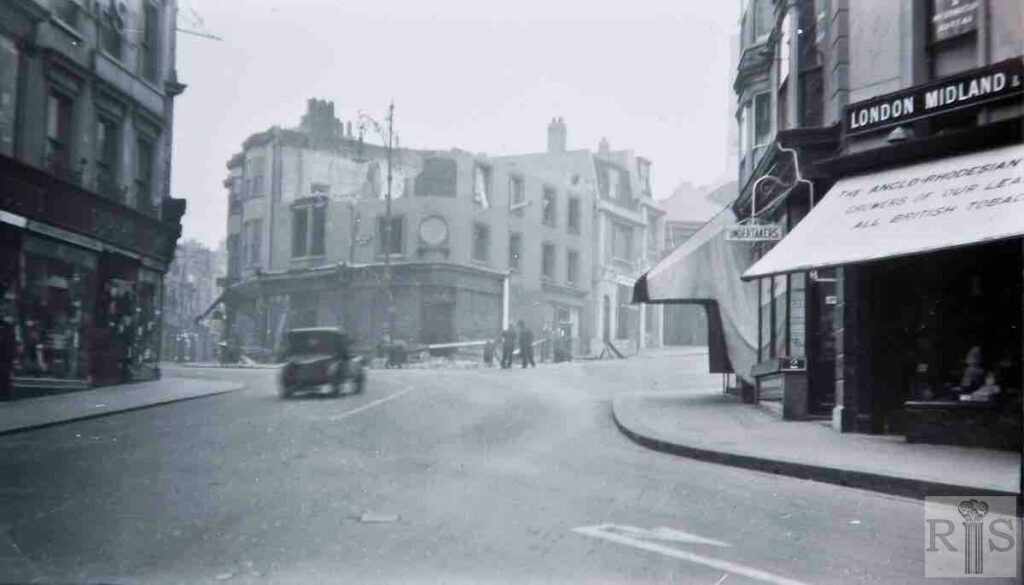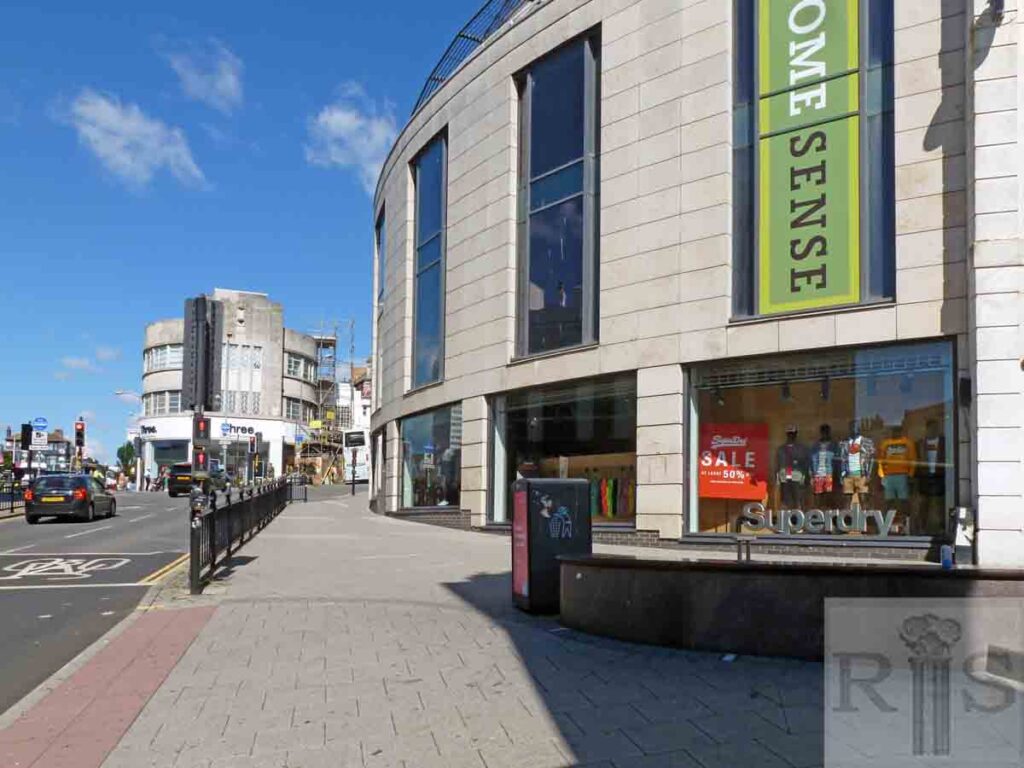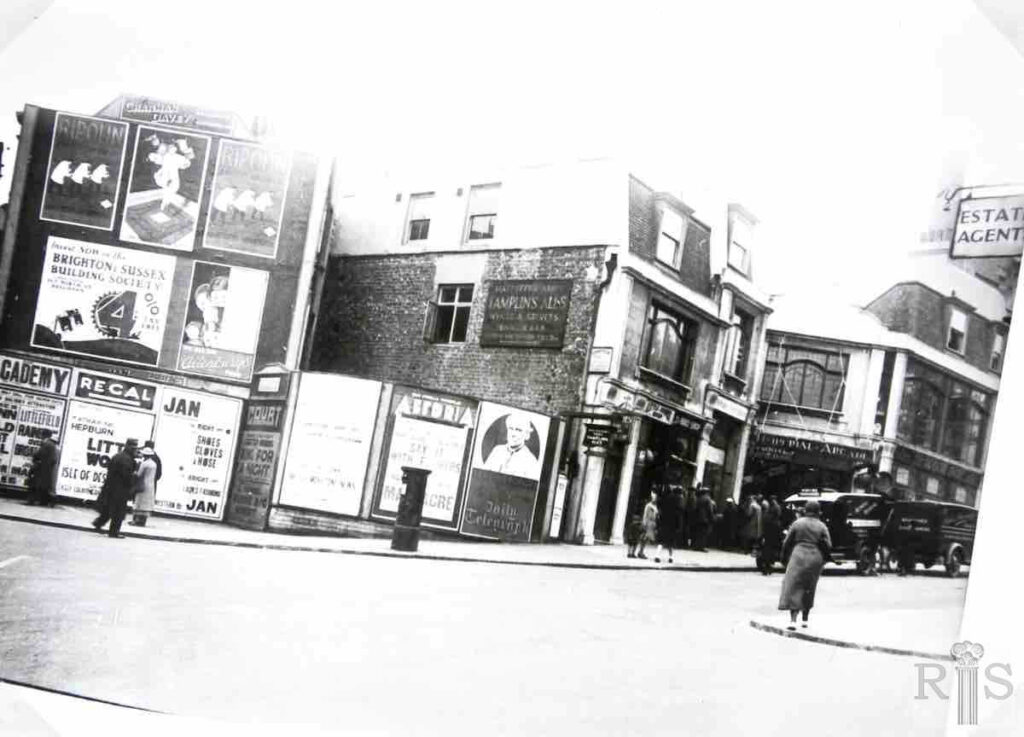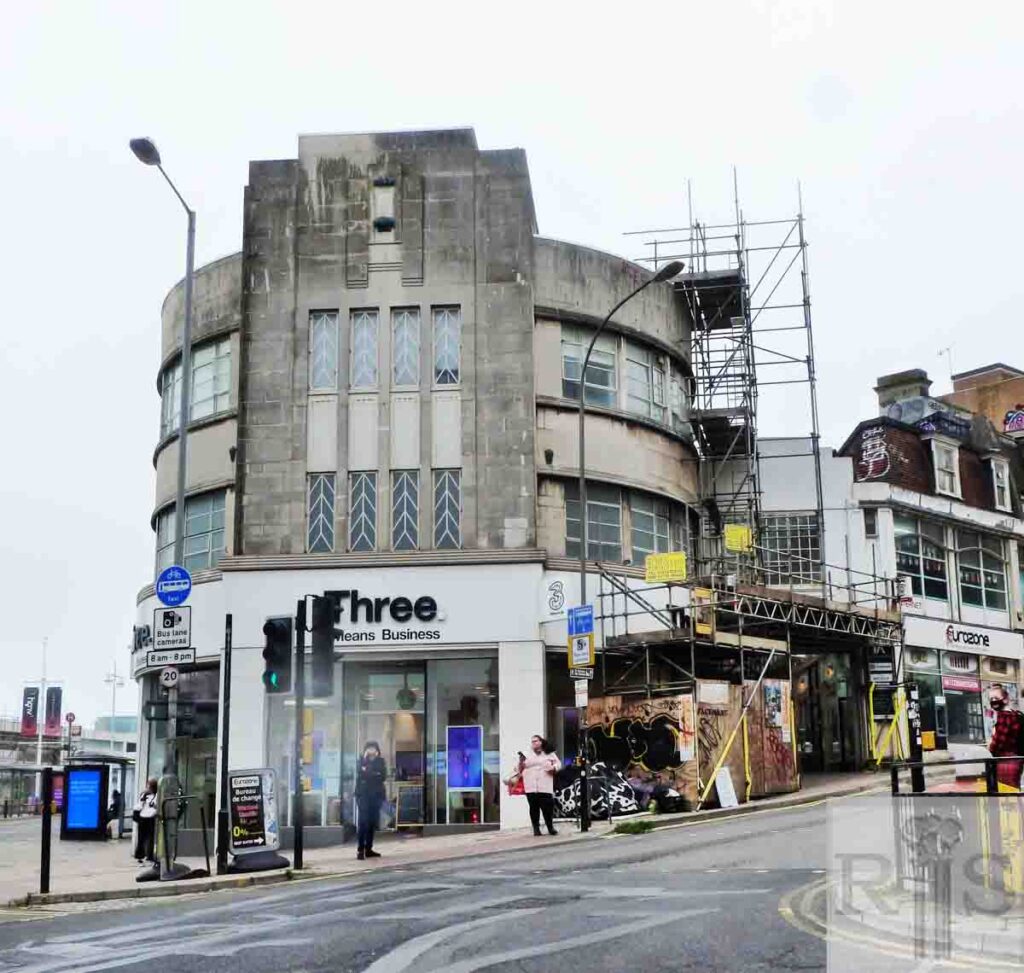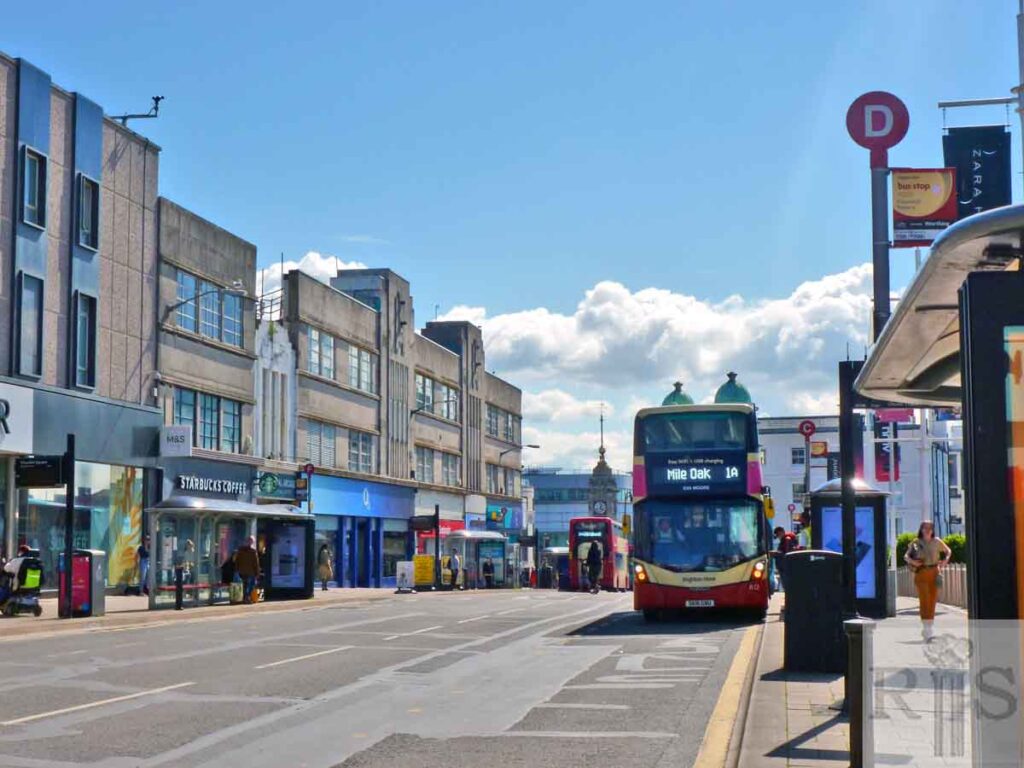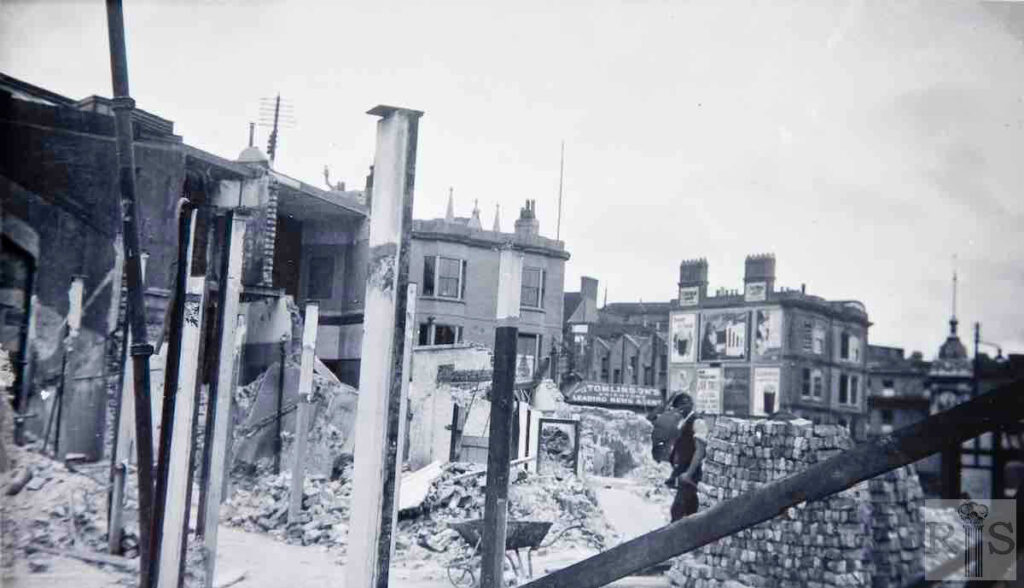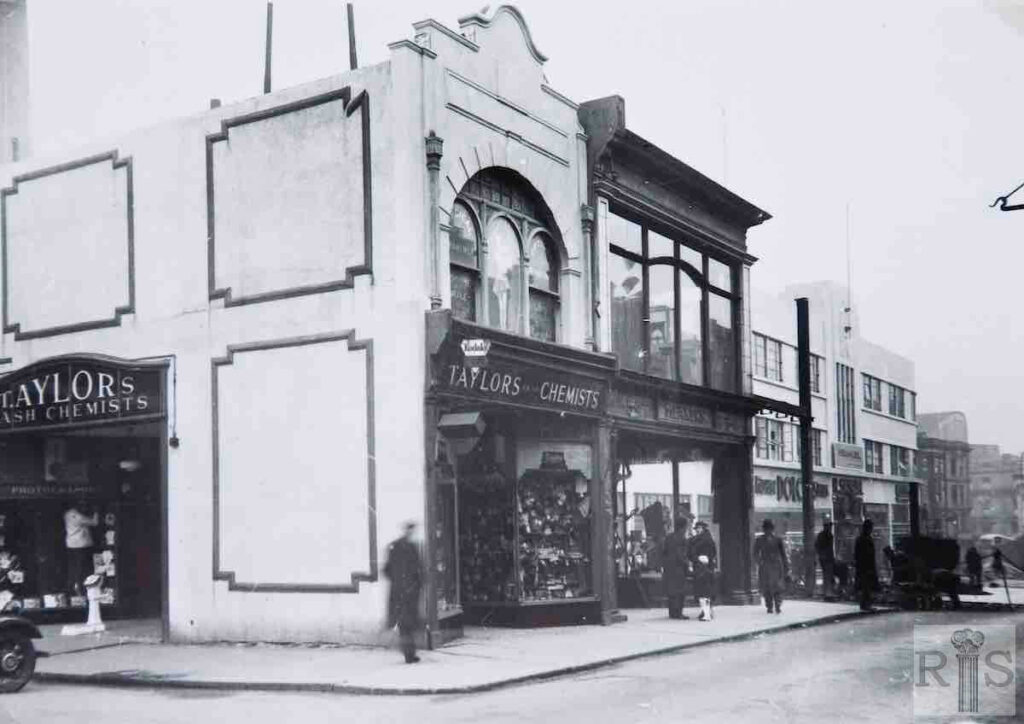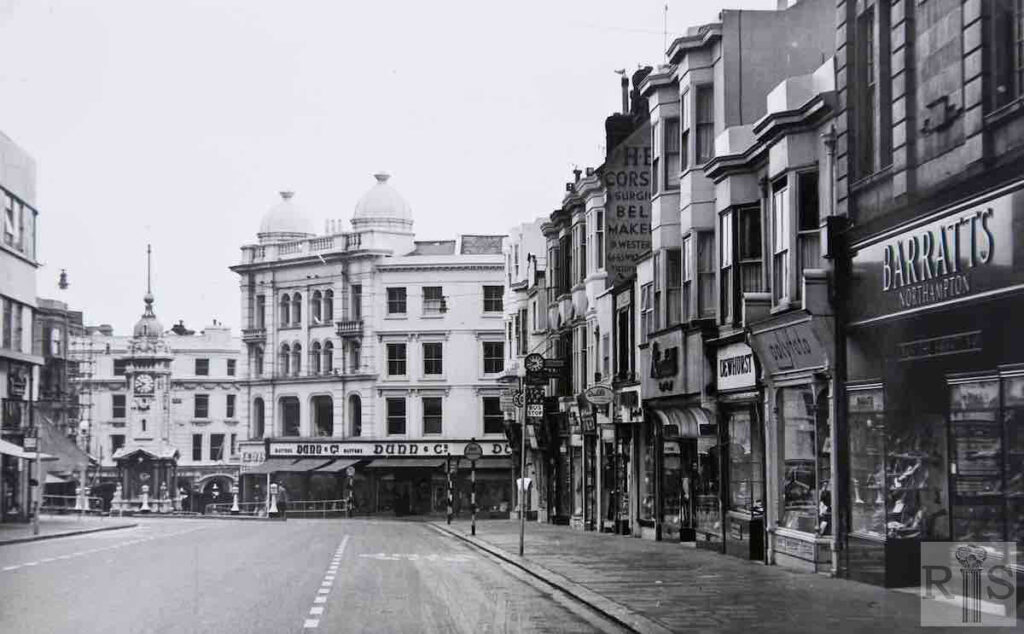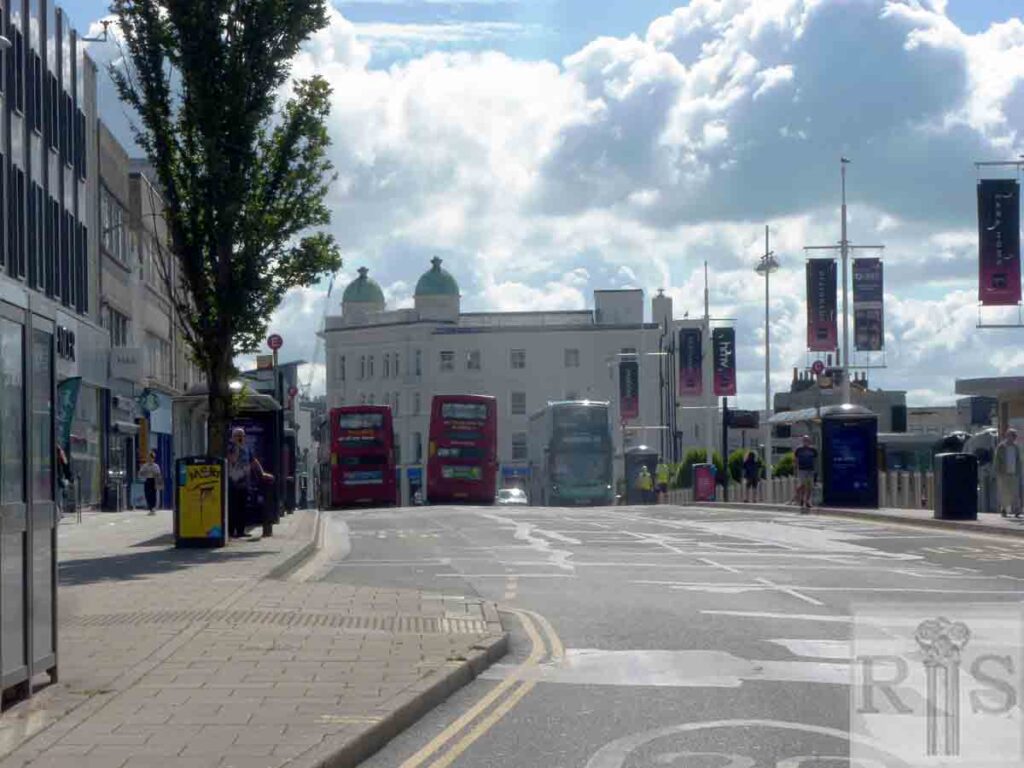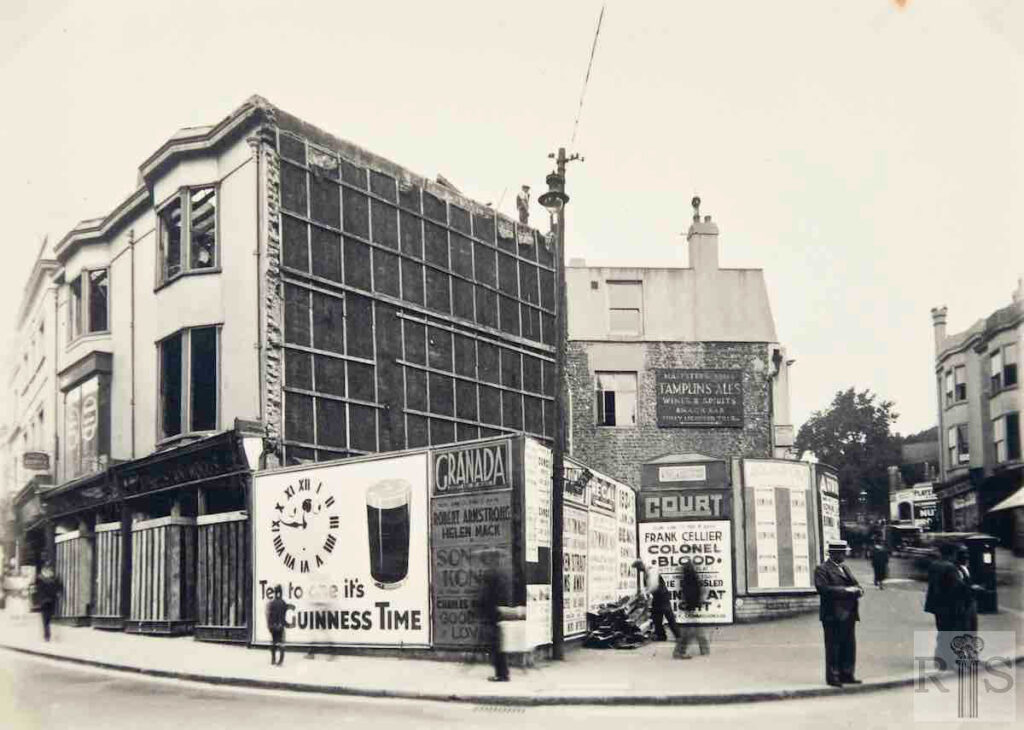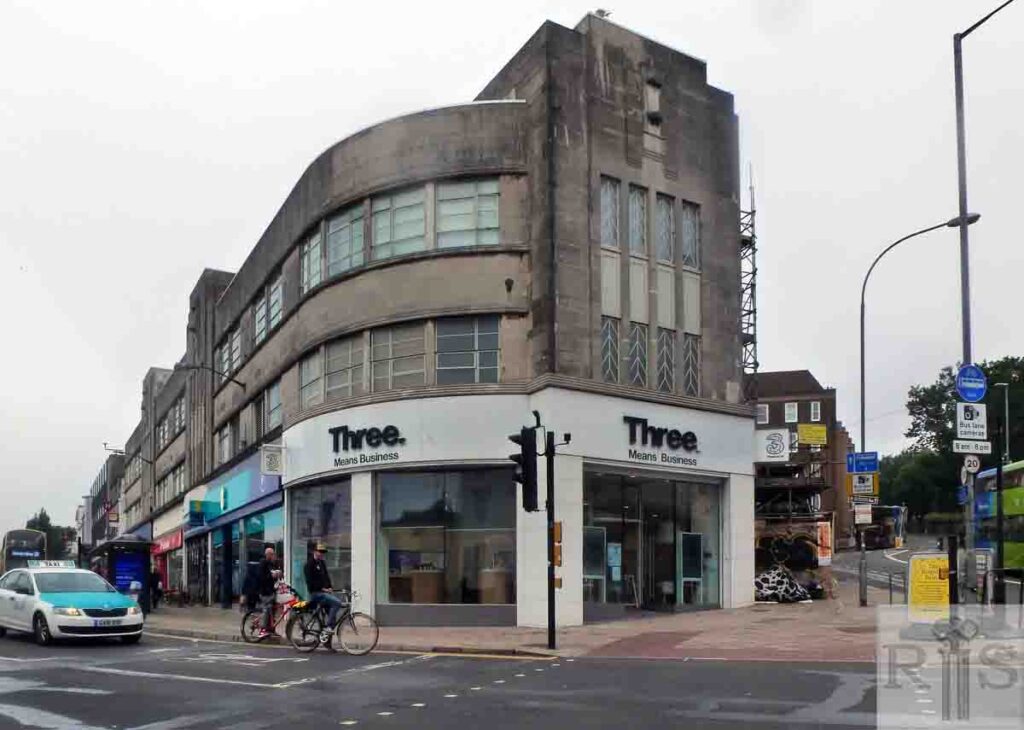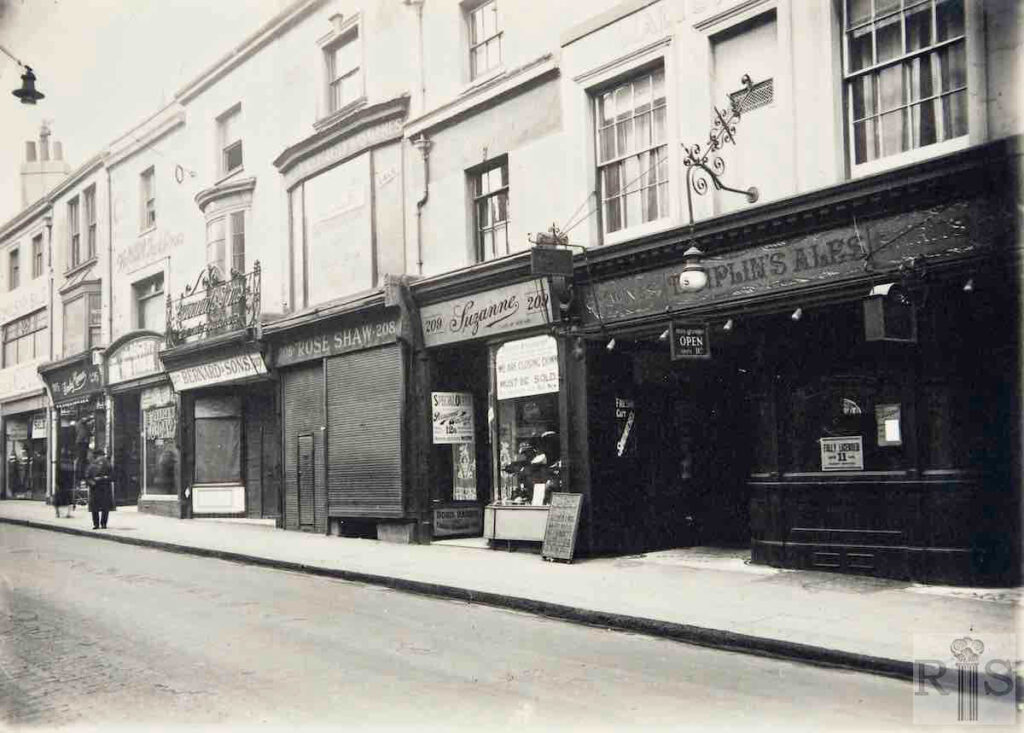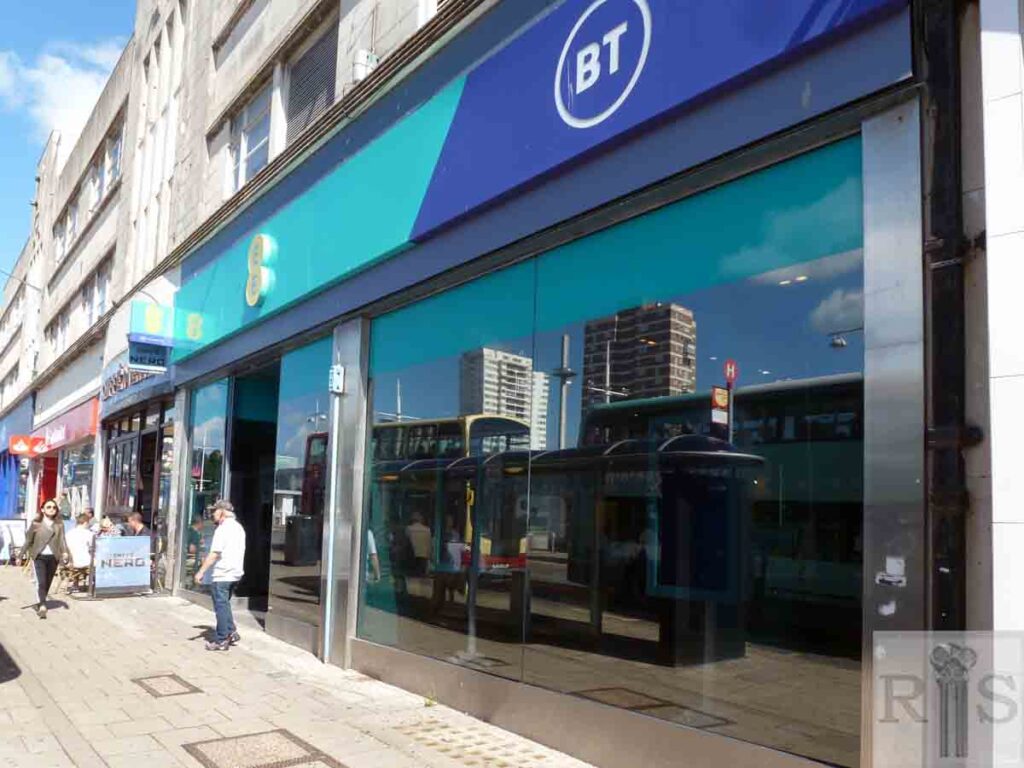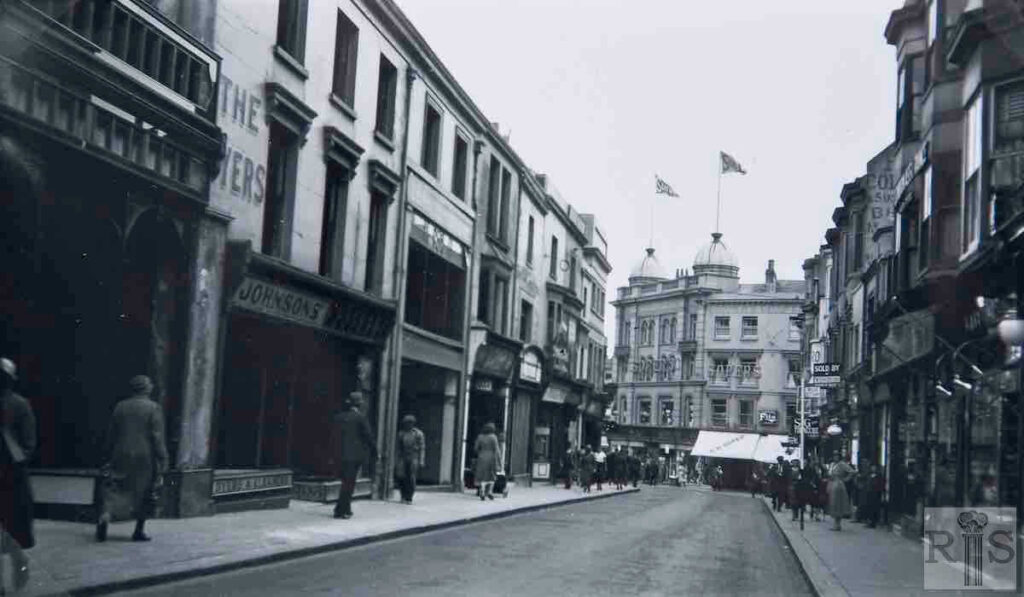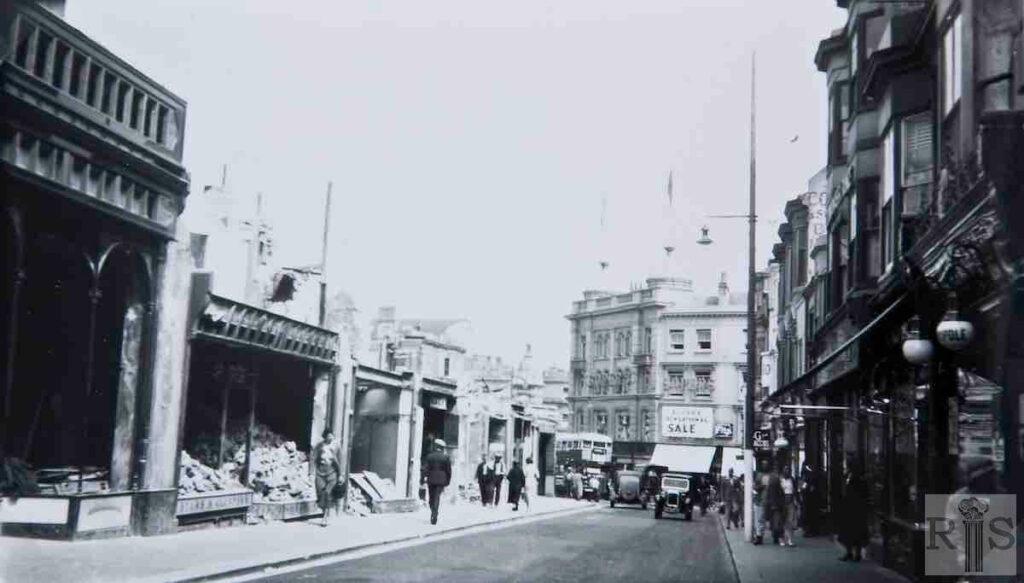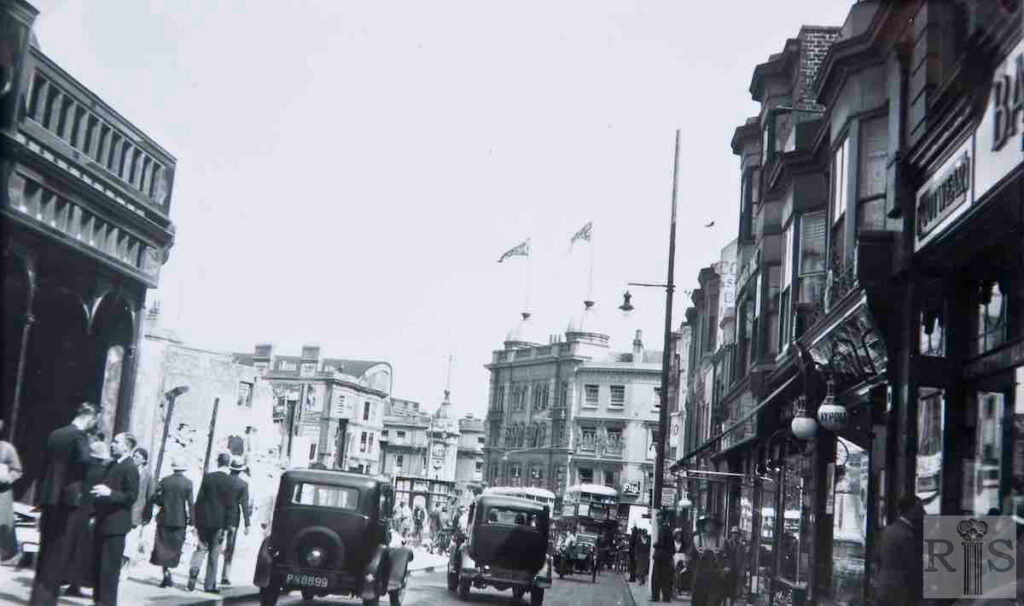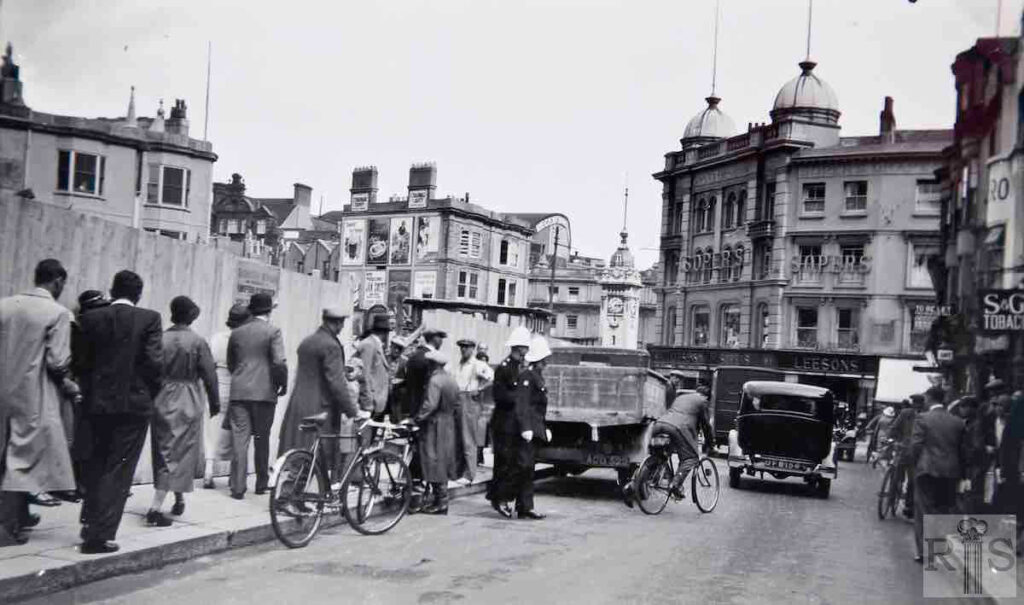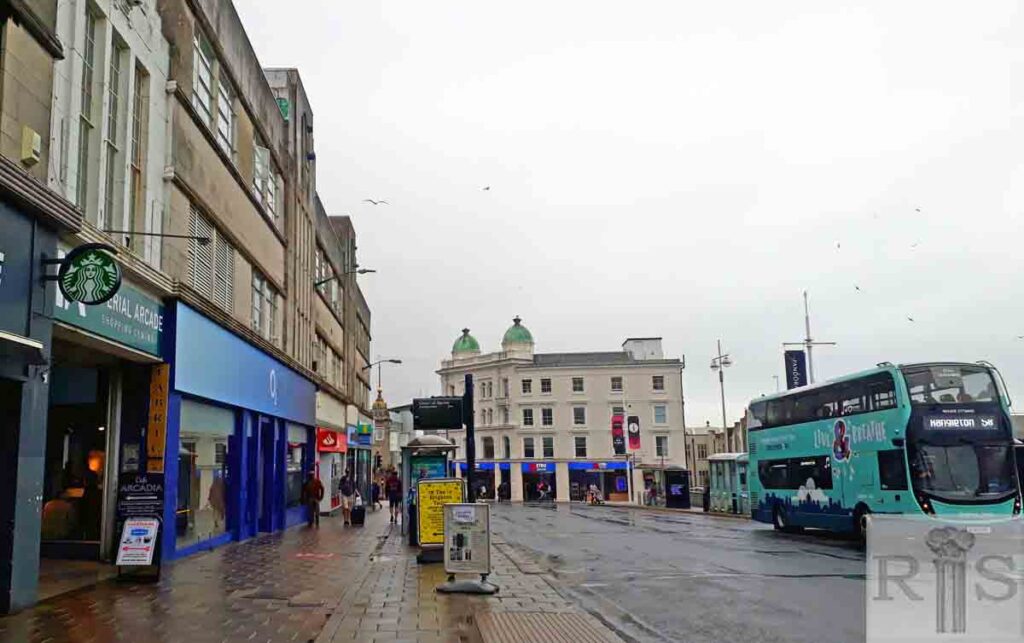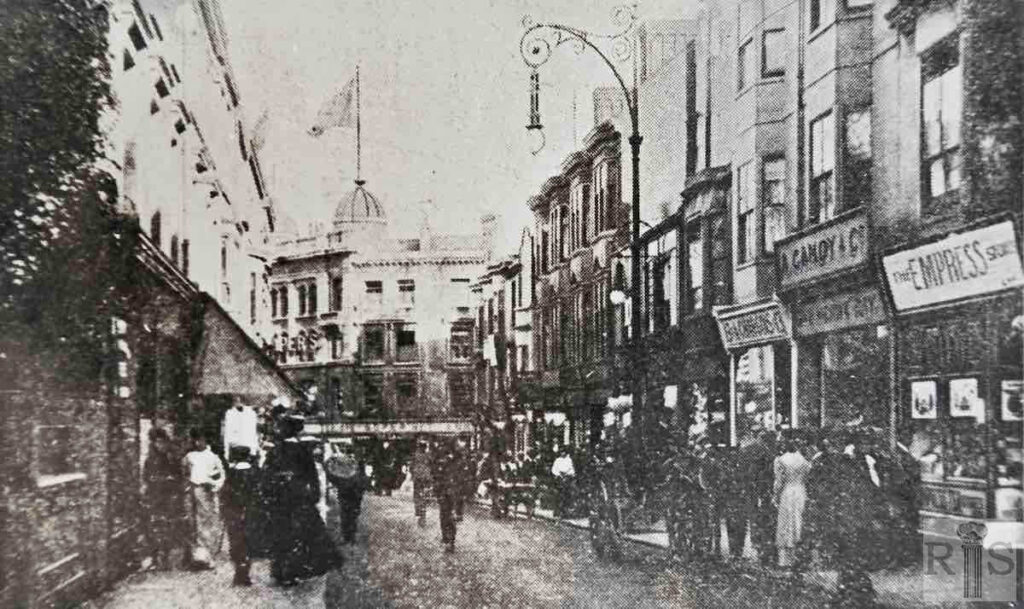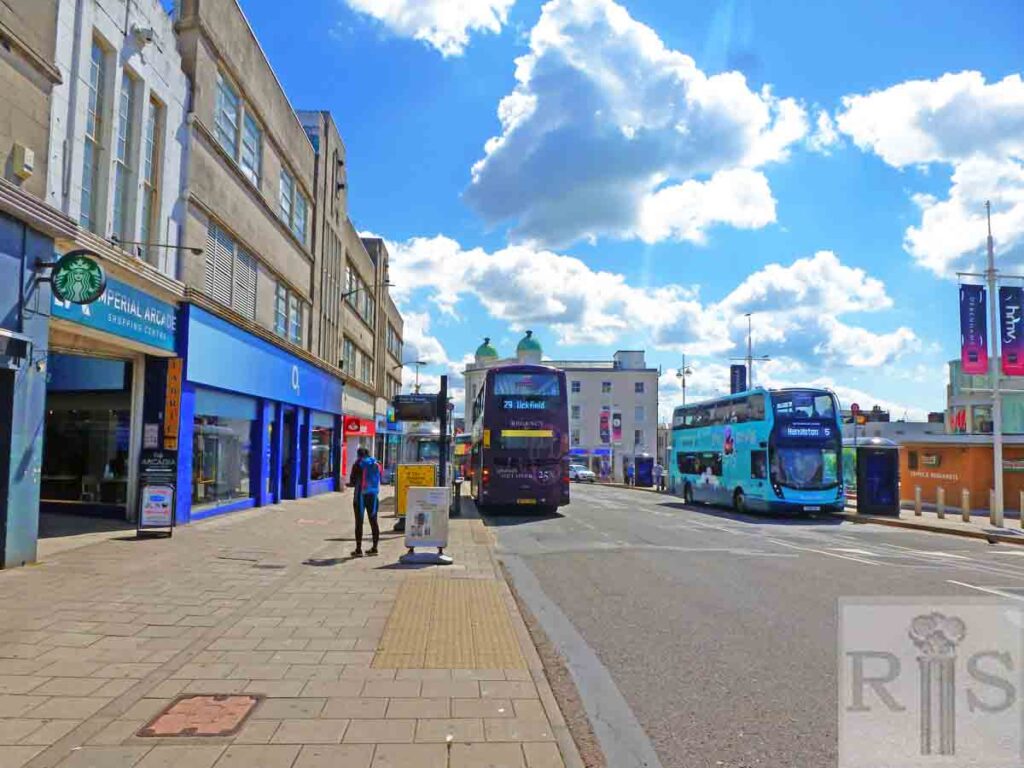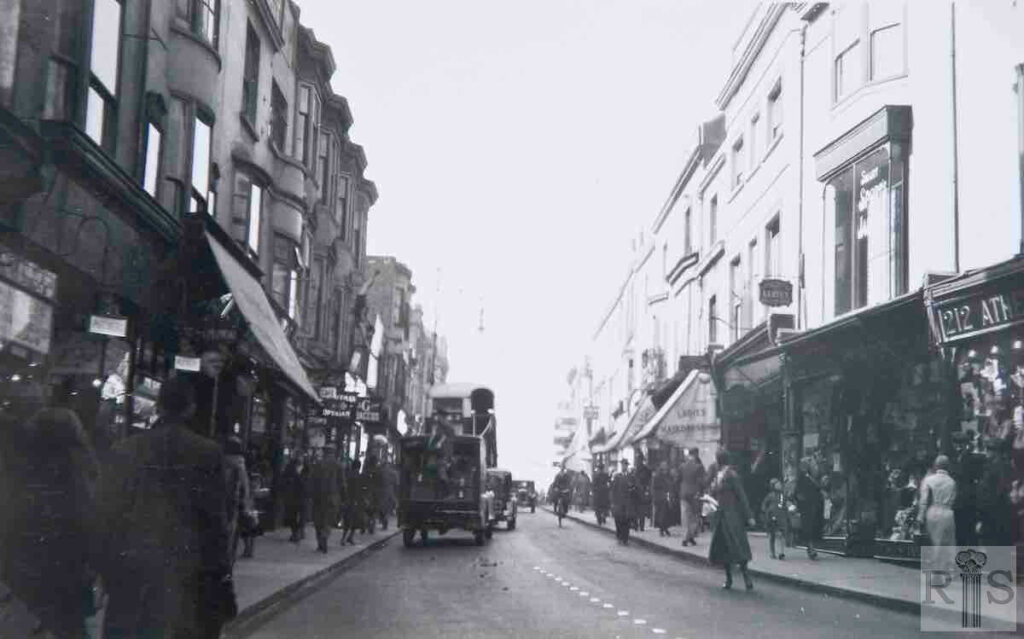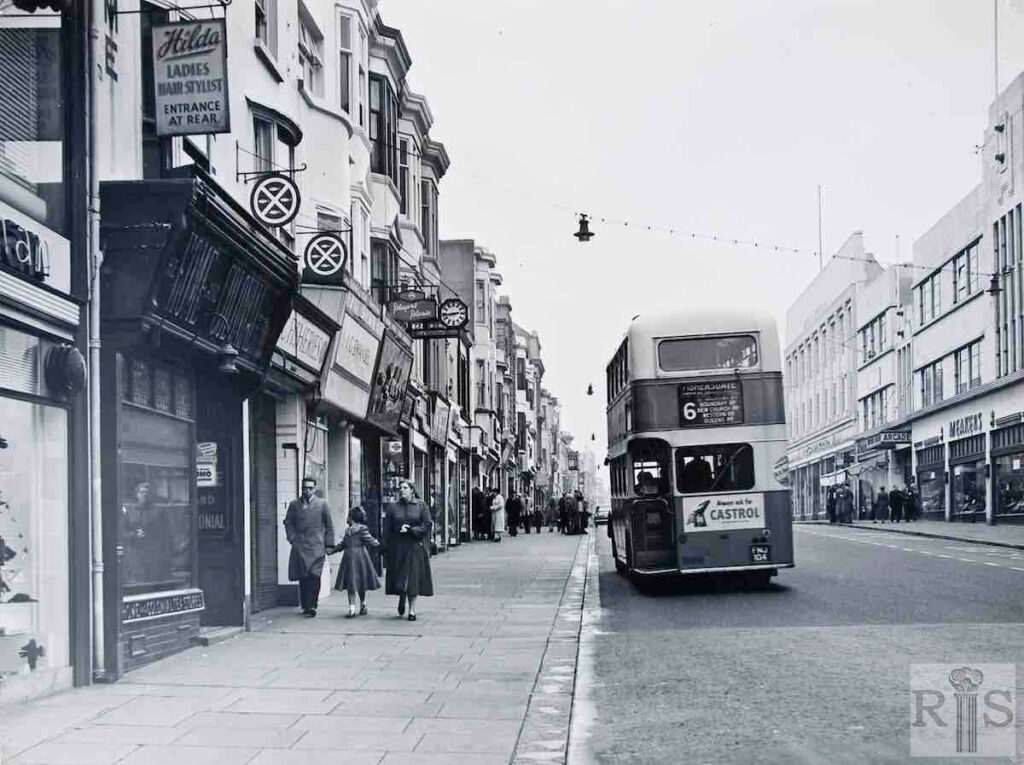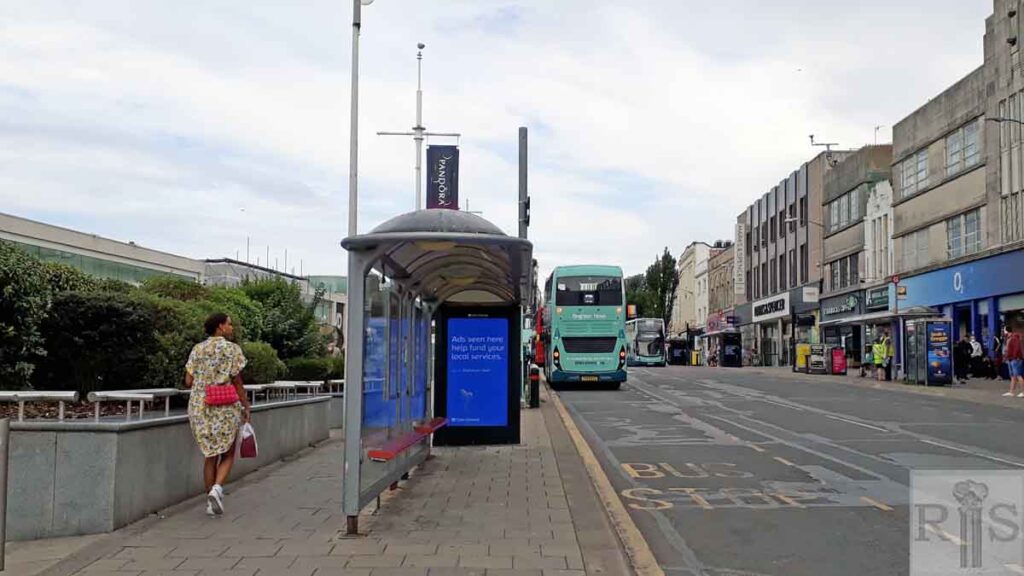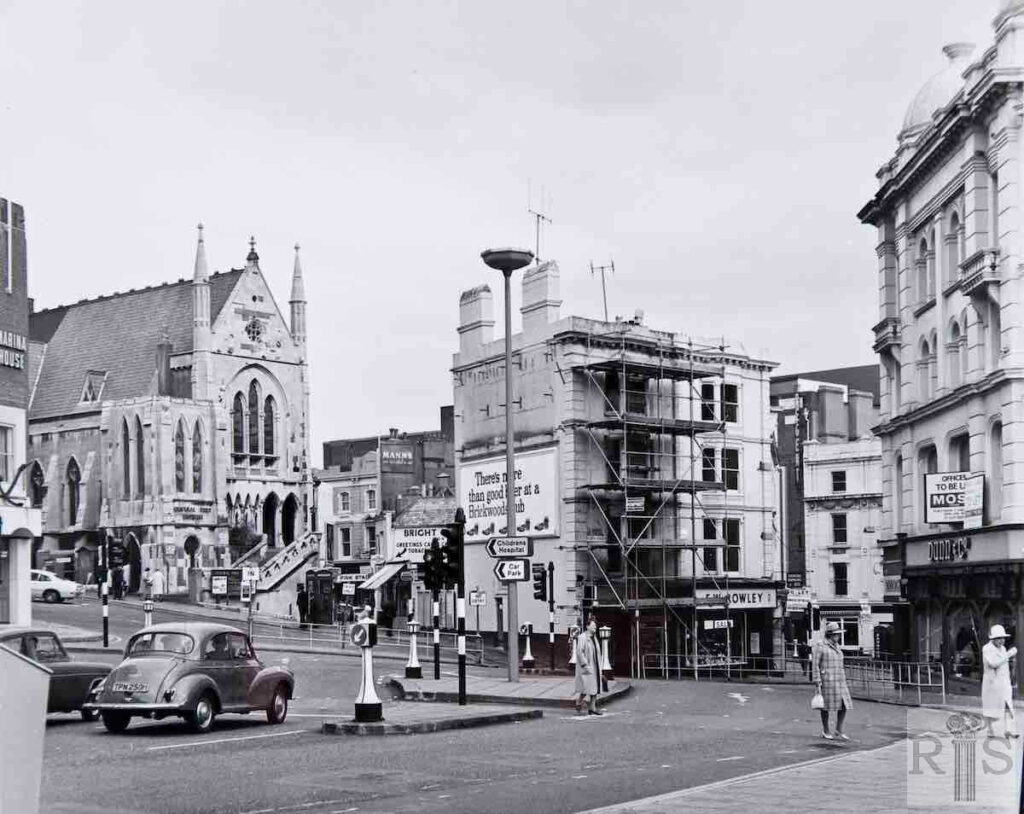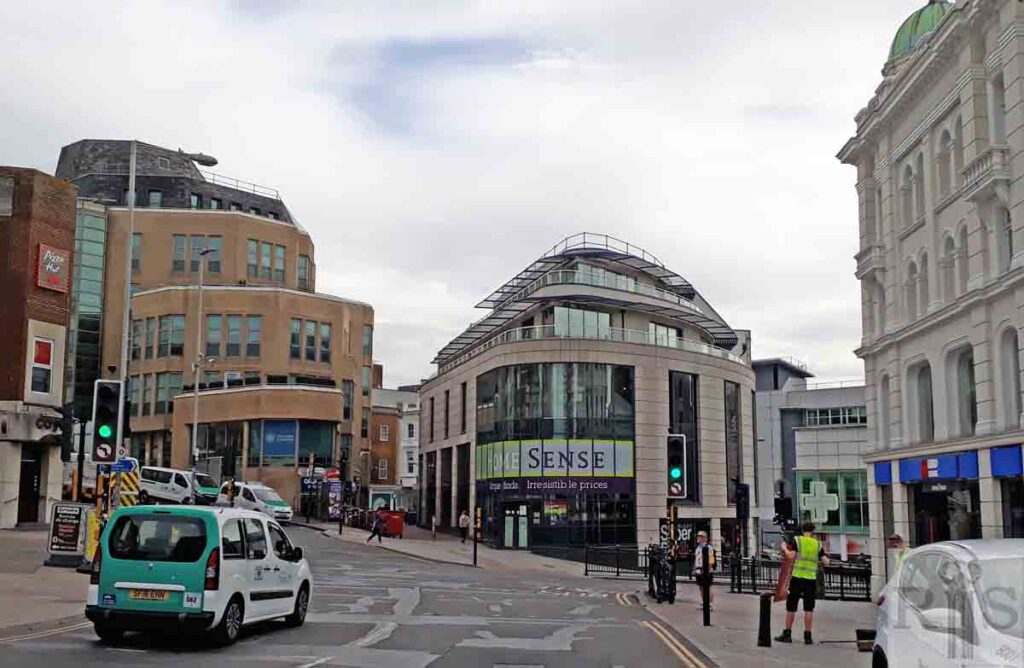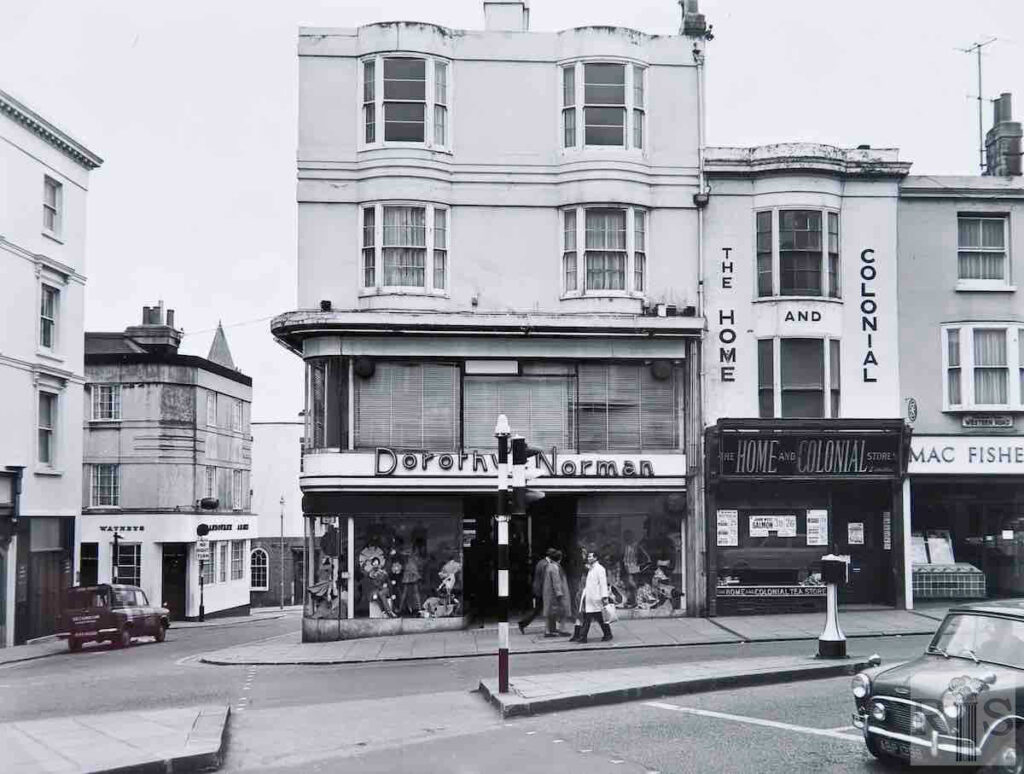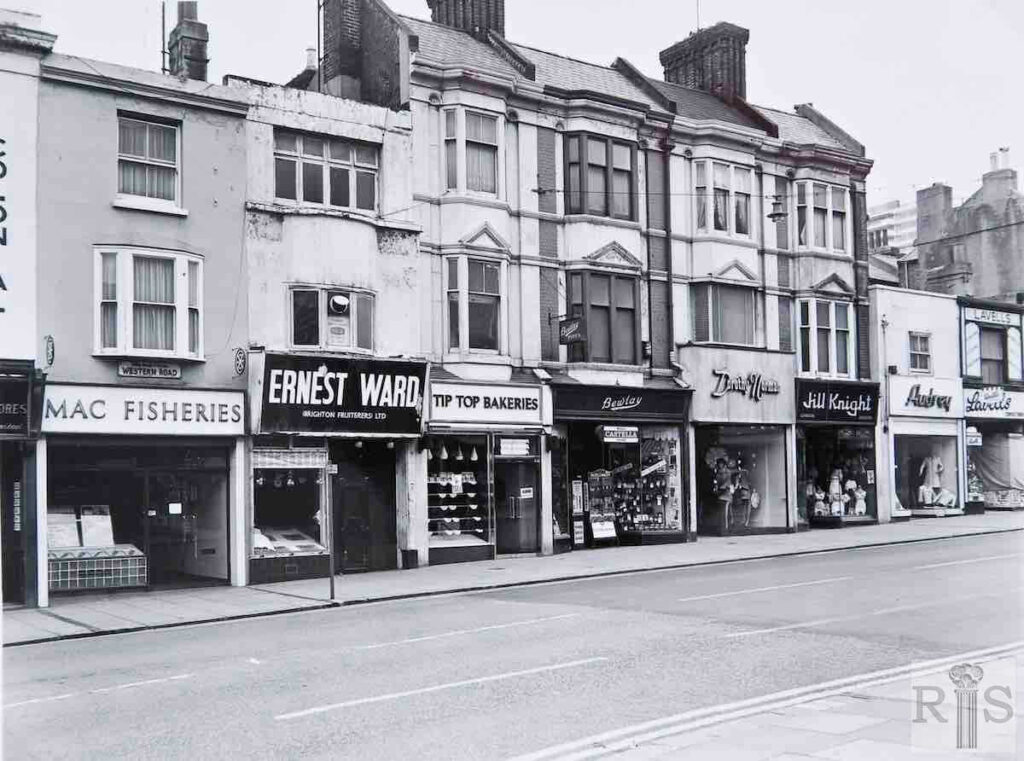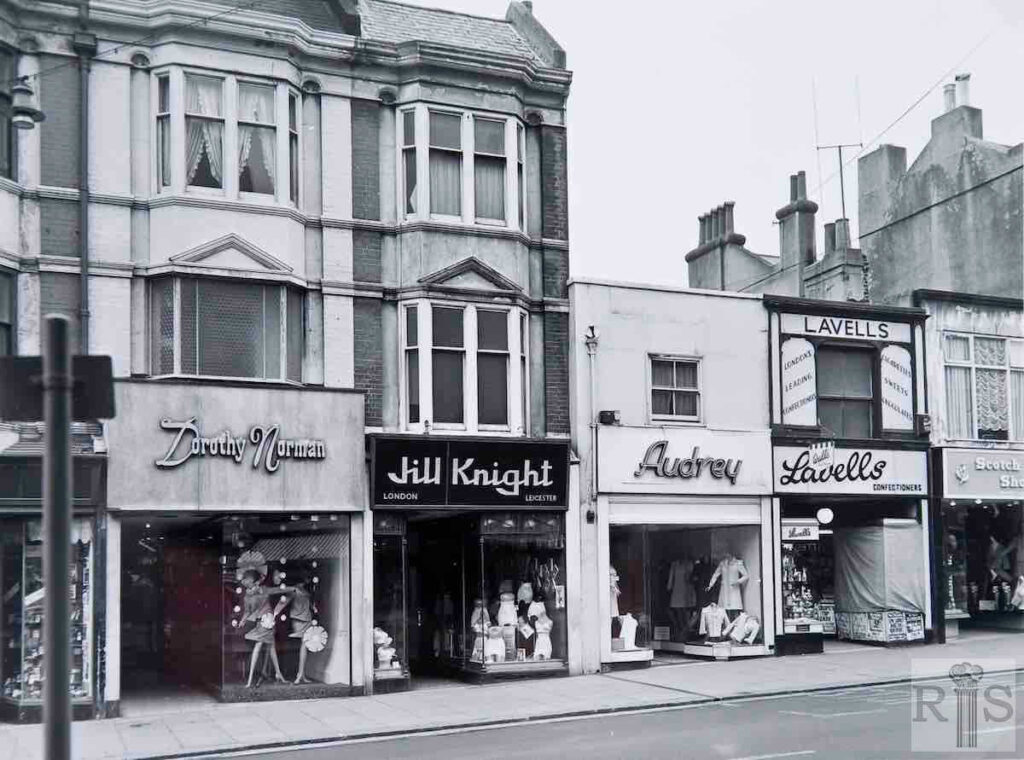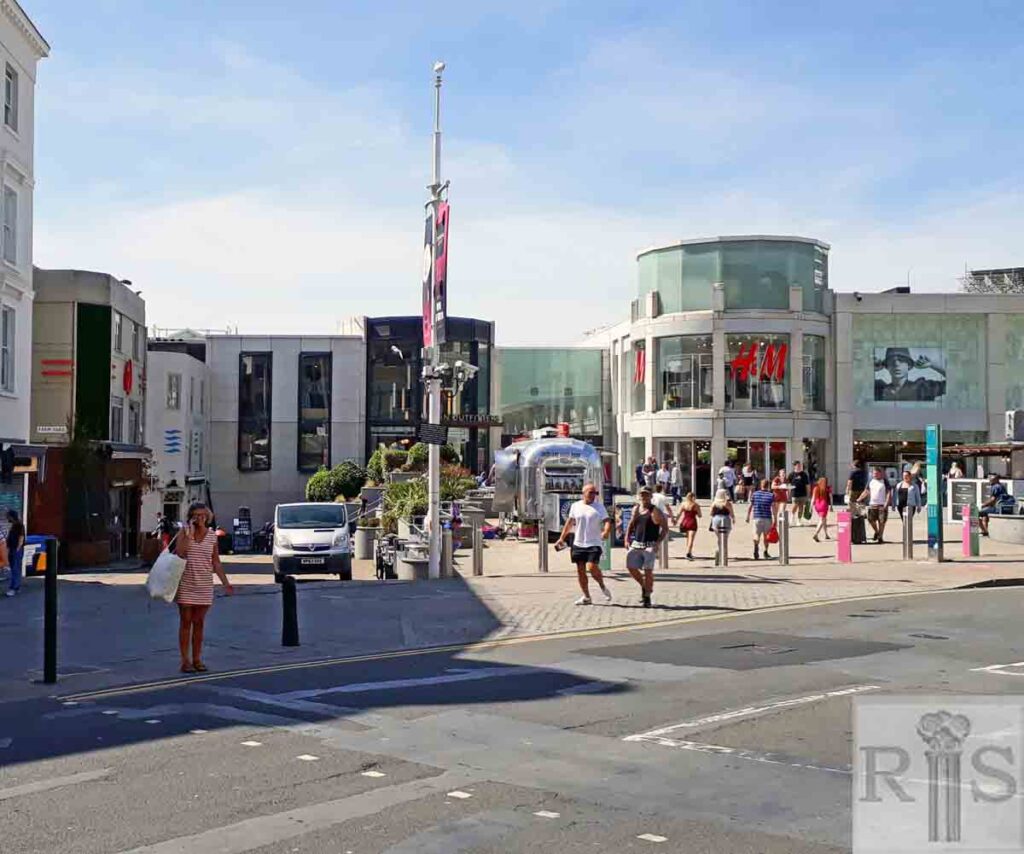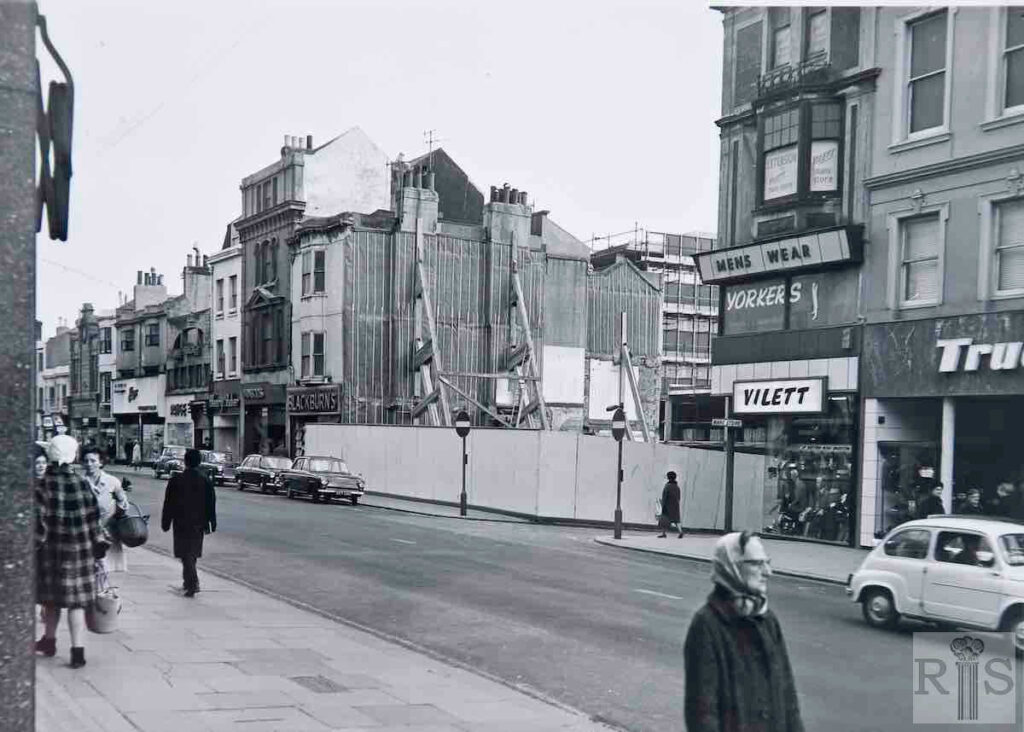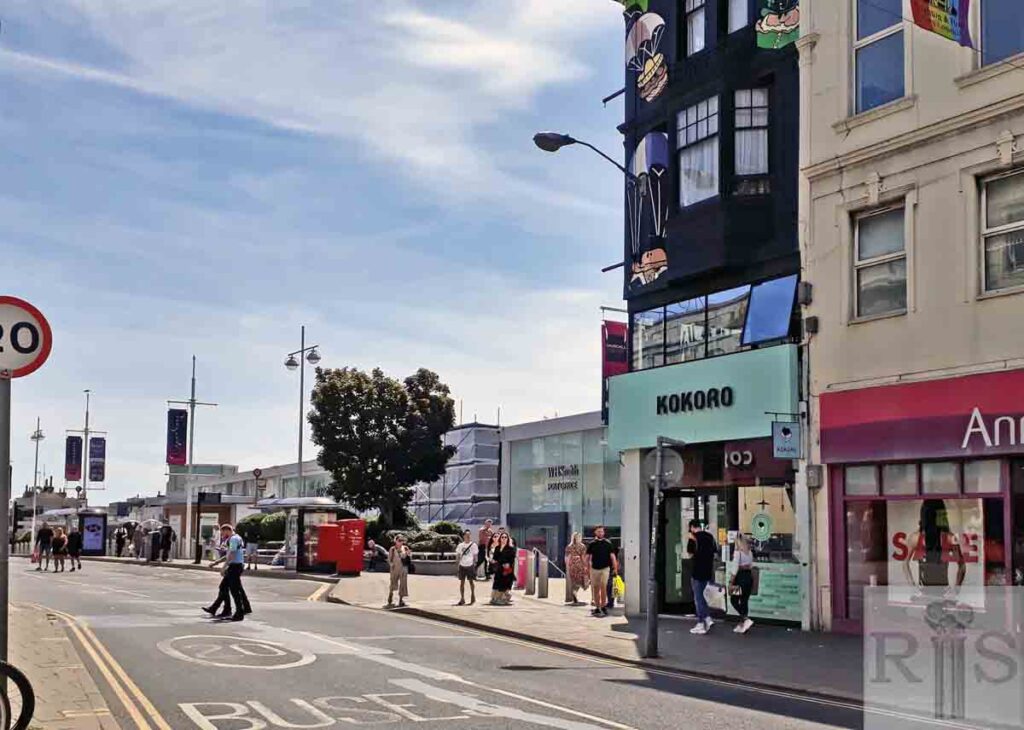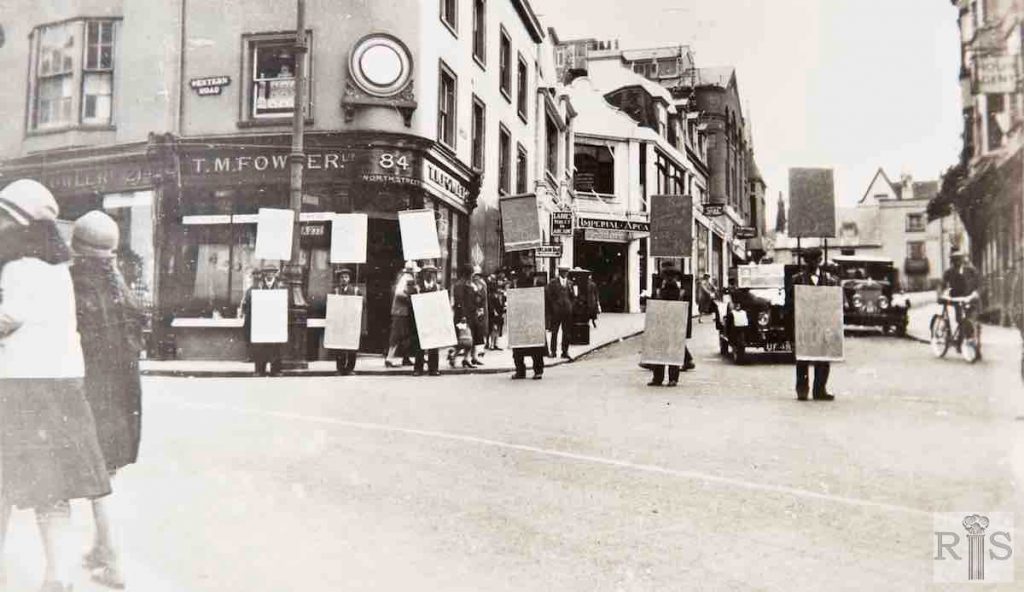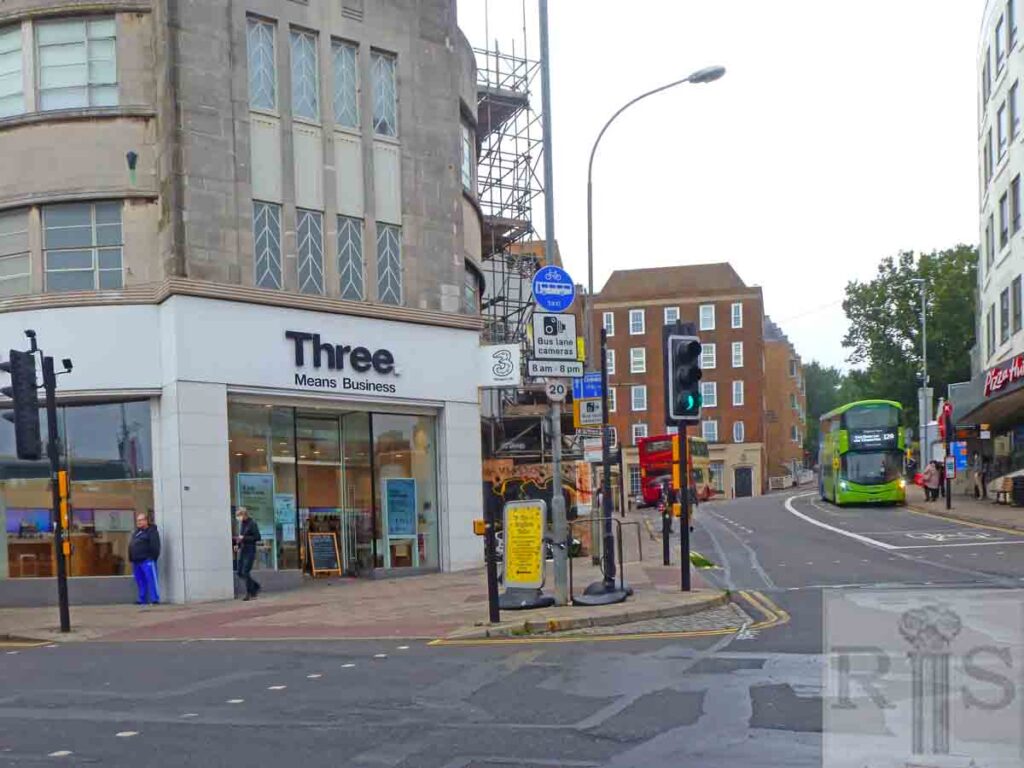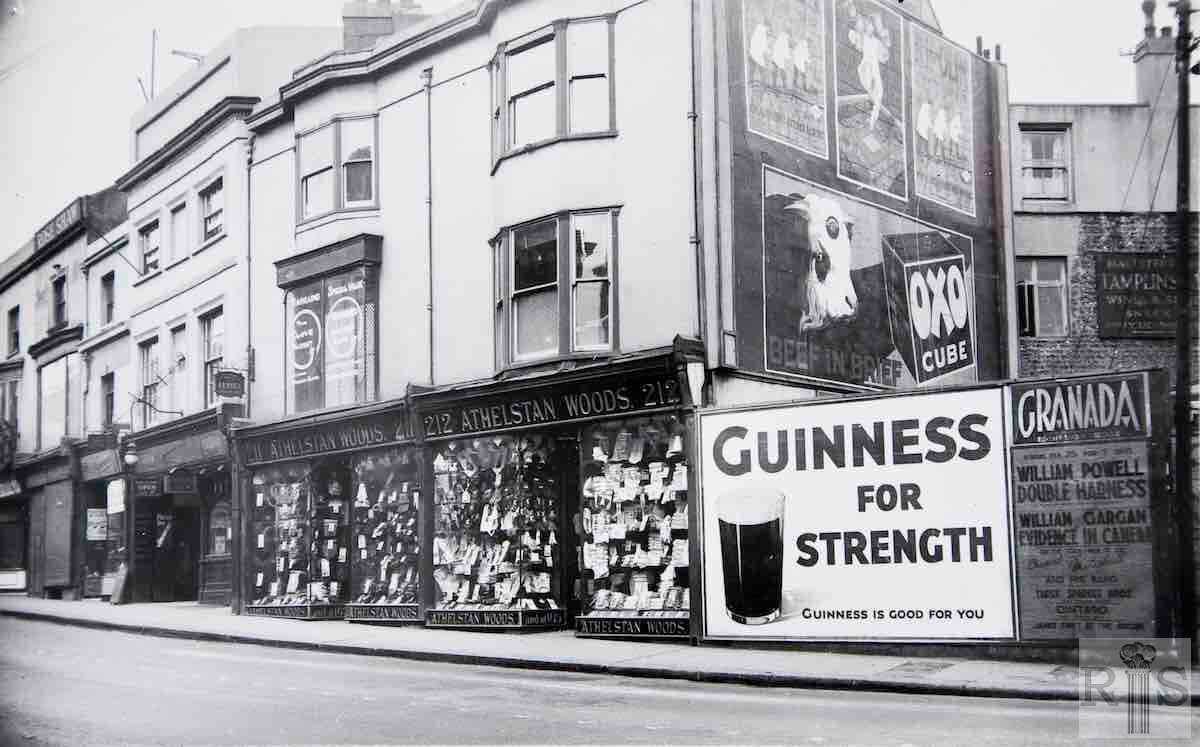
James Gray: Nos 207-212 in February 1934, just a few months before the whole block was demolished. Note the gap left by the earlier removal of Fowler’s Corner. Although the Malsters Arms, No 210, was not one of Brighton’s oldest public houses, the building had been licensed premises for nearly 100 years, being originally a beer house. Additional Information: Athelstan Woods; Guinness; Granada cinema poster. jgc_19_108
James Gray: Summer 1934. The housebreakers have now started work on the demolition of the last block of old Western Road. jgc_19_110
2020: The 1934 image runs from 202 Western Road eastwards. The frontage was then forward of that shown in the 2020 image, about where the bus shelter is now. 202 Western Road has disappeared, replaced by the Western Road entrance to Imperial Arcade seen on the left.
James Gray: The narrow end of old Western Road in 1930. The south side of the road is little changed, although only the Home and Colonial Stores at No 30 is in the same occupation today. Additional Information: C Y Lyon – Optician; Frank Eyeles – Shirts, Corsets. jgc_19_111
2020: In 1930 the building with the domes atop was Soper’s Drapery Emporium at 77-83 North Street. In the 1940s it became Leeson’s drapers and house furnishers. It now houses a branch of the Metro Bank.
James Gray: Fowler’s Corner, at the junction of Dyke Road, Western Road and North Street in 1929. The same photograph appears in the Western Road album with a more informative caption than space permits here [see jgc_19_112 below]. jgc_21_029
James Gray: FOWLER’S CORNER. The well-known landmark shortly before its demolition in 1929. Famed to generations of Brightonians for its black treacle, the shop really formed part of North Street, but was always regarded as an integral part of old Western Road. It had stood looking down the slope of North Street for upwards of 60 years, and with its passing one felt that the days of the old road were numbered. Since rebuilding, I have never heard it referred to as “Barrington’s Corner”! Note the very acute turn into the narrow Western Road. Also the North Street entrance to Imperial Arcade. [See also jgc_21_029 above for an almost identical image] jgc_19_112
James Gray: Scenes of the widening at the eastern end, between Regent Hill and the Clock Tower. [See also jgc_19_116 and 117 below and jgc_19_115 on the Western Road (2) page.] jgc_19_118
James Gray: Scenes at the eastern end of the old road, between 1930 and 1935. The cleared site of Fowler’s Corner – April 13, 1930. jgc_19_137
James Gray: A later photograph, probably of 1934, which advertises the Astoria Cinema, opened in 1933, as well as three other cinemas and the Brighton and Sussex Building Society, forerunner of the Alliance & Leicester, with its Head Office in North Street. jgc_19_114
2020: Three, the mobile phone store at 211 Western Road, is in the part of Imperial Arcade remodelled by Garrett & Son in 1934 to look like the prow of a ship. To the right of the Dyke Road entrance to the arcade is Eurozone, which offers a currency exchange service and is in the part which was not remodelled. (Photographer: Jane Southern)
James Gray: Scenes of the widening at the eastern end, between Regent Hill and the Clock Tower. [See also jgc_19_117 below, jgc_19_118 above and jgc_19_115 on the Western Road (2) page.] jgc_19_116
2020: 200 Western Road is on the left of the original image. This is now the eastern end of Marks and Spencer, just visible on the left of the 2020 image which shows the shops and flats above them of Imperial Arcade. The Clock Tower is now easier to see because of the road widening that took place in the 1930s.
James Gray: Scenes of the widening at the eastern end, between Regent Hill and the Clock Tower. [See also jgc_19_116 and 118 above and jgc_19_115 on the Western Road (2) page.] jgc_19_117
James Gray: Clearing the site after the removal of the old buildings. On the left can be seen the backs of the original shops on the west side of the Arcade, and the Arcade roof which has not yet been demolished. jgc_19_119
James Gray: Scenes at the eastern end of the old road, between 1930 and 1935. The clearance almost complete. Only two buildings 200 and 201 still remain of the old, narrow road. jgc_19_139
James Gray: The eastern end of Western Road in late 1966, a few months prior to the demolition of all these shops (on the right), before work could start on the vast Churchill Square. jgc_19_154
James Gray: Newly built shops are nearly ready for occupation and road widening is in progress. The Clock Tower and the Quadrant come into view for the first time. Now only two of the old buildings, Taylors and Meakers, remain. On the left of the photograph can be seen the tall chimney of the defunct Smithers’ Brewery. jgc_19_120
2020: This is similar to image jgc_19_116 but taken from the other side of Western Road. The most prominent building in the 2020 image is what in 1929-34 was part of Soper’s Drapery Emporium at 77-83 North Street. In 2020 Metro Bank is at No 81. The whole of this side of the building was exposed when the shops on the south side of Western Road seen in the original image were demolished in the late 1960s. (Photographer: Jane Southern)
James Gray: After the buildings at Fowler’s Corner were removed in 1929, the site remained empty for several years while the leases of adjoining buildings were acquired. These photographs [jgc_19_122 and 123] were taken in June 1934. jgc_19_122
2020: See caption for jgc_19_108 above. (Photographer: Jane Southern)
James Gray: After the buildings at Fowler’s corner were removed in 1929, the site remained empty for several years while the leases of adjoining buildings were acquired. These photographs [jgc_19_122 and 123] were taken in June 1934. This view shows 206-211 Western Road, shortly before demolition was started. jgc_19_123
2020: A view of the shops today at this point on Western Road. The frontages in 1934 were further south as the road had not yet been widened.
James Gray: Four stages in the demolition of the shop premises from the Imperial Arcade to Fowler’s Corner. 33 years later, in 1967, the shops facing these were to suffer the same indignity. jgc_19_124
James Gray: See caption for jgc_19_124. jgc_19_125
James Gray: See caption for jgc_19_124. jgc_19_126
James Gray: See caption for jgc_19_124. jgc_19_127
James Gray: Clearance of the old buildings beyond the Arcade, in progress. jgc_19_130
2020: The 2020 image gives a closer view of the entrance to Imperial Arcade. Without the shops on the southern side of Western Road there is a view onto the cul-de-sac called Farm Yard, visible here behind the blue bus. (Photographer: Jane Southern)
James Gray: This is a rather indistinct reproduction from a Guide Book photograph of 1907. Its chief interest lies in the glimpse that it gives of the entrance to the Brewery Manager’s cottage, No 202 referred to on other pages. The tree that grew in his garden can clearly be seen. jgc_19_128
2020: In 1907 the Empress Tea Shop, seen on the right in the James Gray image, was at 15 Western Road, one of 28 shops demolished in the late 1960s to make way for Churchill Square.
James Gray: View of the narrow end of Western Road, looking west from the corner of Upper Russell Street. jgc_19_129
2020: All the buildings on the left of the 1930 image were demolished in the late 1960s prior to the development of Churchill Square shopping centre. On the left of the 2020 image is a glimpse of the frontage of the shopping centre which was refurbished in 2018. The road is much wider and less elegant now than it was in 1930. (Photographer: Jane Southern)
James Gray: At the time of this photograph, in November 1955, few people could have guessed that most of the buildings on the south side of this busy shopping road, to beyond the distant car, would have gone within a dozen years. In fact, in late 1967, the line of shops Nos 1-28 were swept away and the cleared site is now the entrance to Churchill Square. Where was all the traffic? jgc_19_152
James Gray: A view at the end of Western Road, taken on 11 October 1970. Although the picture shows other buildings, such as the Central Free Church, its purpose was to record 1 and 2, North Street Quadrant. These buildings were about to be removed and were demolished in February 1971. jgc_19_153
2020: Home Sense, a retailer of homeware and gifts, dominates the 2005 development which replaced everything between Air Street and North Street Quadrant except The Quadrant public house.
James Gray: After the extensive widening of the period 1926-1936, this road remained virtually unchanged for 30 years. Then, as part of the vast West Street redevelopment, all the shop buildings on the south side between Upper Russell Street and Clarence Street were demolished during 1967. On this and succeeding pages are shown most of the shops, built about 1830 in the back gardens of the houses of Grenville Place. 1-11 Western Road, on the south side, westwards from Upper Russell Street. jgc_19_158
James Gray: See caption for jgc_19_158. jgc_19_159
James Gray: 8-16 Western Road. The Rudledge family occupied No. 12 The Scotch Wool Shop, for more than 80 years. The business of stay and corset makers was started here in the 1860s and the family lived in the little house behind 11 Grenville Place. In 1947, the business closed and this tiny shop with only a 13′ [13 foot] frontage was sold at auction for £14,100. jgc_19_160
James Gray: The start of the clearance of the old shop properties at the extreme eastern end of Western Road, prior to the revealing of the vista of the new Churchill Square which had been in progress in the rear for some time. This photograph clearly shows how the one time separate houses of Western Road and Grenville Place had, over the years, been joined together to give greater depth to the ground floor shops. These photographs, as well as those nine on the previous four pages, were taken on 19 March 1967. [See other 1967 images on this page and the Western Road (2) page.] jgc_19_166
2020: The bus lay-by seen in the 2020 image is where the pavement was in 1967. The original image extended as far as 16 Western Road, demolished together with the rest of 1-28 Western Road prior to the development of Churchill Square. 29 and 30 Western Road are shown in both images. (Photographer: Jane Southern)
James Gray: Two more photographs (and following) of the area where this road joined North Street. For some reason many pictures were taken of this, even then, busy spot. View of Fowler’s Corner in the 1920s, with a parade of sandwich men. Sadly we cannot read what they were advertising. Note the two numbers in Fowler’s address – 214 Western Road and 84 North Street. Both photographs show the entrance to the original Imperial Arcade, soon to be rebuilt. jgc_19_113
James Gray: [Image identical to jgc_19_113 above] At the top of the street. Fowler’s corner and a view towards Dyke Road. Period unknown but by the ladies cloche hats obviously the 1920s. jgc_21_143
2020: Although the Three mobile phone shop looks as though it is in Dyke Road, its address is 211 Western Road as most of the shop is round the corner to the left. The entrance to Imperial Arcade is visible but the scaffolding hides the Dyke Road frontage for the arcade, unaffected by the 1934 remodelling. On the right, Pizza Hut is at 2 Dyke Road. Until 1952, buildings on each side of the Dyke Road from here to the junction with Upper North Street had North Street addresses. The 1950s office block in the background is Century House at 15-19 Dyke Road and an entrance to Wykeham Terrace is to the right of the 12A bus. (Photographer: Jane Southern)
